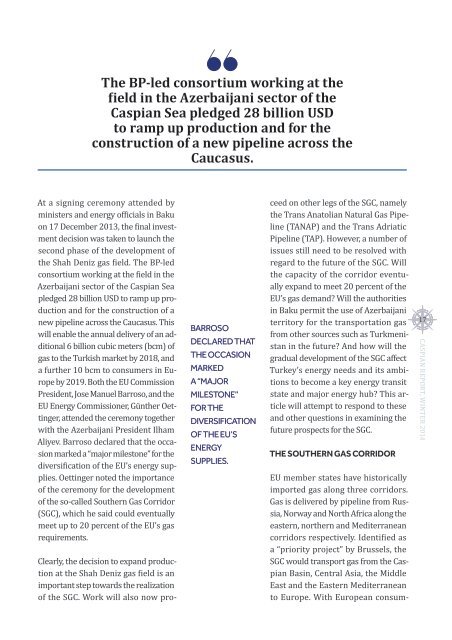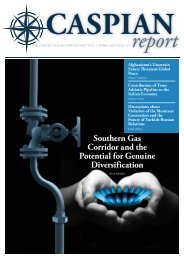Caspian Report - Issue 06 - Winter 2014
Create successful ePaper yourself
Turn your PDF publications into a flip-book with our unique Google optimized e-Paper software.
The BP-led consortium working at the<br />
field in the Azerbaijani sector of the<br />
<strong>Caspian</strong> Sea pledged 28 billion USD<br />
to ramp up production and for the<br />
construction of a new pipeline across the<br />
Caucasus.<br />
At a signing ceremony attended by<br />
ministers and energy officials in Baku<br />
on 17 December 2013, the final investment<br />
decision was taken to launch the<br />
second phase of the development of<br />
the Shah Deniz gas field. The BP-led<br />
consortium working at the field in the<br />
Azerbaijani sector of the <strong>Caspian</strong> Sea<br />
pledged 28 billion USD to ramp up production<br />
and for the construction of a<br />
new pipeline across the Caucasus. This<br />
will enable the annual delivery of an additional<br />
6 billion cubic meters (bcm) of<br />
gas to the Turkish market by 2018, and<br />
a further 10 bcm to consumers in Europe<br />
by 2019. Both the EU Commission<br />
President, Jose Manuel Barroso, and the<br />
EU Energy Commissioner, Günther Oettinger,<br />
attended the ceremony together<br />
with the Azerbaijani President Ilham<br />
Aliyev. Barroso declared that the occasion<br />
marked a “major milestone” for the<br />
diversification of the EU’s energy supplies.<br />
Oettinger noted the importance<br />
of the ceremony for the development<br />
of the so-called Southern Gas Corridor<br />
(SGC), which he said could eventually<br />
meet up to 20 percent of the EU’s gas<br />
requirements.<br />
BARROSO<br />
DECLARED THAT<br />
THE OCCASION<br />
MARKED<br />
A “MAJOR<br />
MILESTONE”<br />
FOR THE<br />
DIVERSIFICATION<br />
OF THE EU’S<br />
ENERGY<br />
SUPPLIES.<br />
Clearly, the decision to expand production<br />
at the Shah Deniz gas field is an<br />
important step towards the realization<br />
of the SGC. Work will also now proceed<br />
on other legs of the SGC, namely<br />
the Trans Anatolian Natural Gas Pipeline<br />
(TANAP) and the Trans Adriatic<br />
Pipeline (TAP). However, a number of<br />
issues still need to be resolved with<br />
regard to the future of the SGC. Will<br />
the capacity of the corridor eventually<br />
expand to meet 20 percent of the<br />
EU’s gas demand Will the authorities<br />
in Baku permit the use of Azerbaijani<br />
territory for the transportation gas<br />
from other sources such as Turkmenistan<br />
in the future And how will the<br />
gradual development of the SGC affect<br />
Turkey’s energy needs and its ambitions<br />
to become a key energy transit<br />
state and major energy hub This article<br />
will attempt to respond to these<br />
and other questions in examining the<br />
future prospects for the SGC.<br />
THE SOUTHERN GAS CORRIDOR<br />
EU member states have historically<br />
imported gas along three corridors.<br />
Gas is delivered by pipeline from Russia,<br />
Norway and North Africa along the<br />
eastern, northern and Mediterranean<br />
corridors respectively. Identified as<br />
a “priority project” by Brussels, the<br />
SGC would transport gas from the <strong>Caspian</strong><br />
Basin, Central Asia, the Middle<br />
East and the Eastern Mediterranean<br />
to Europe. With European consum-<br />
17<br />
CASPIAN REPORT, WINTER <strong>2014</strong>










